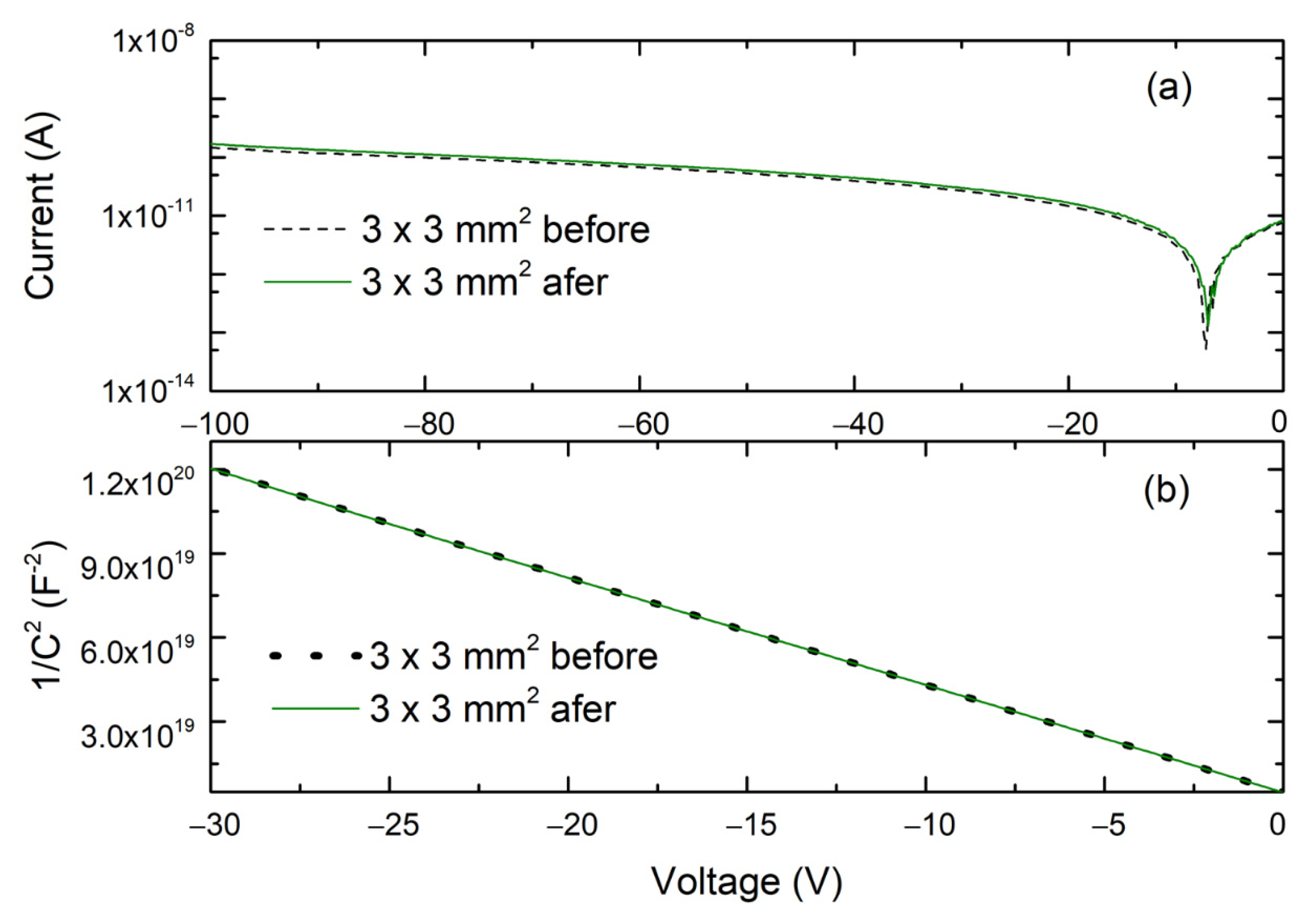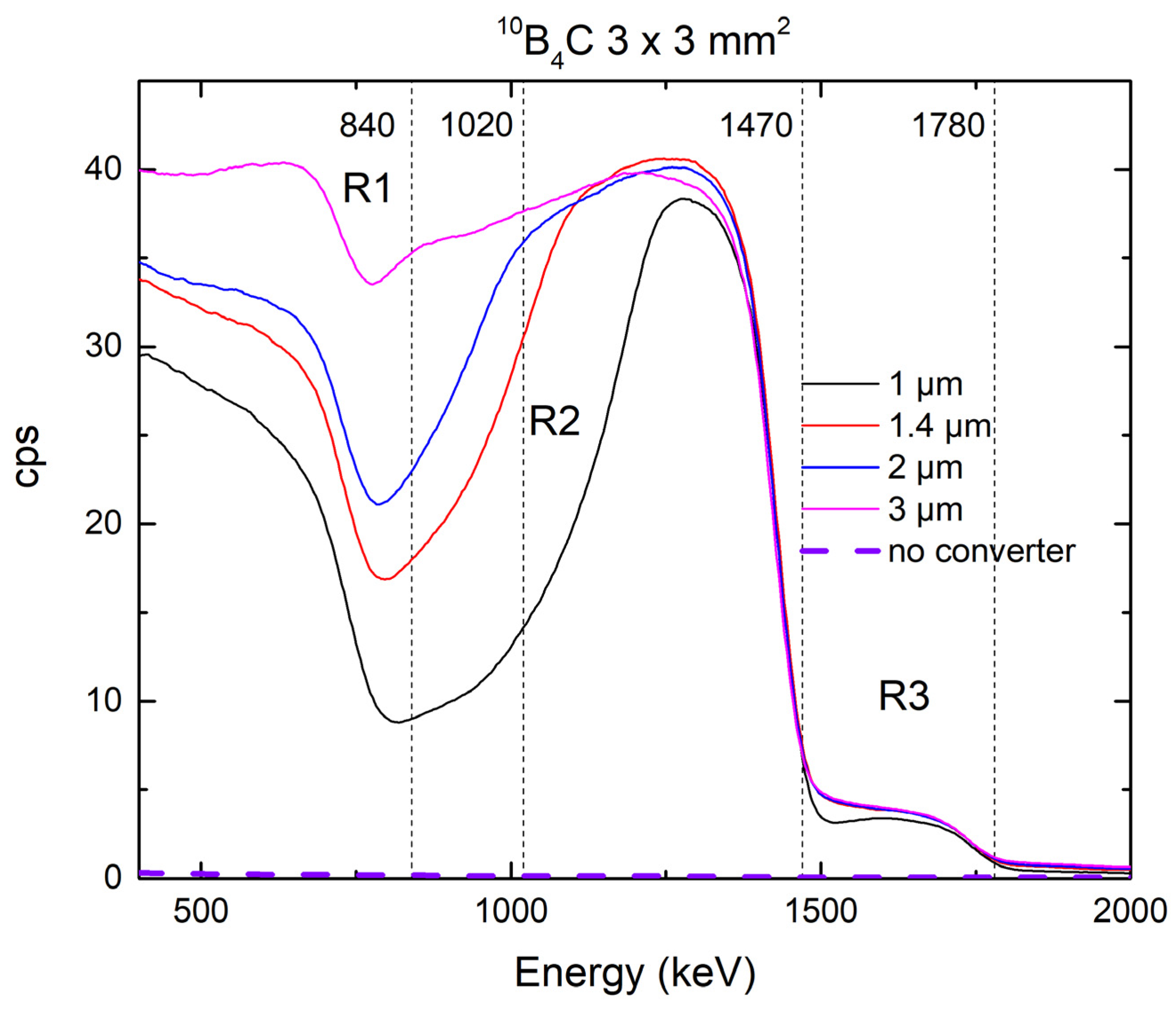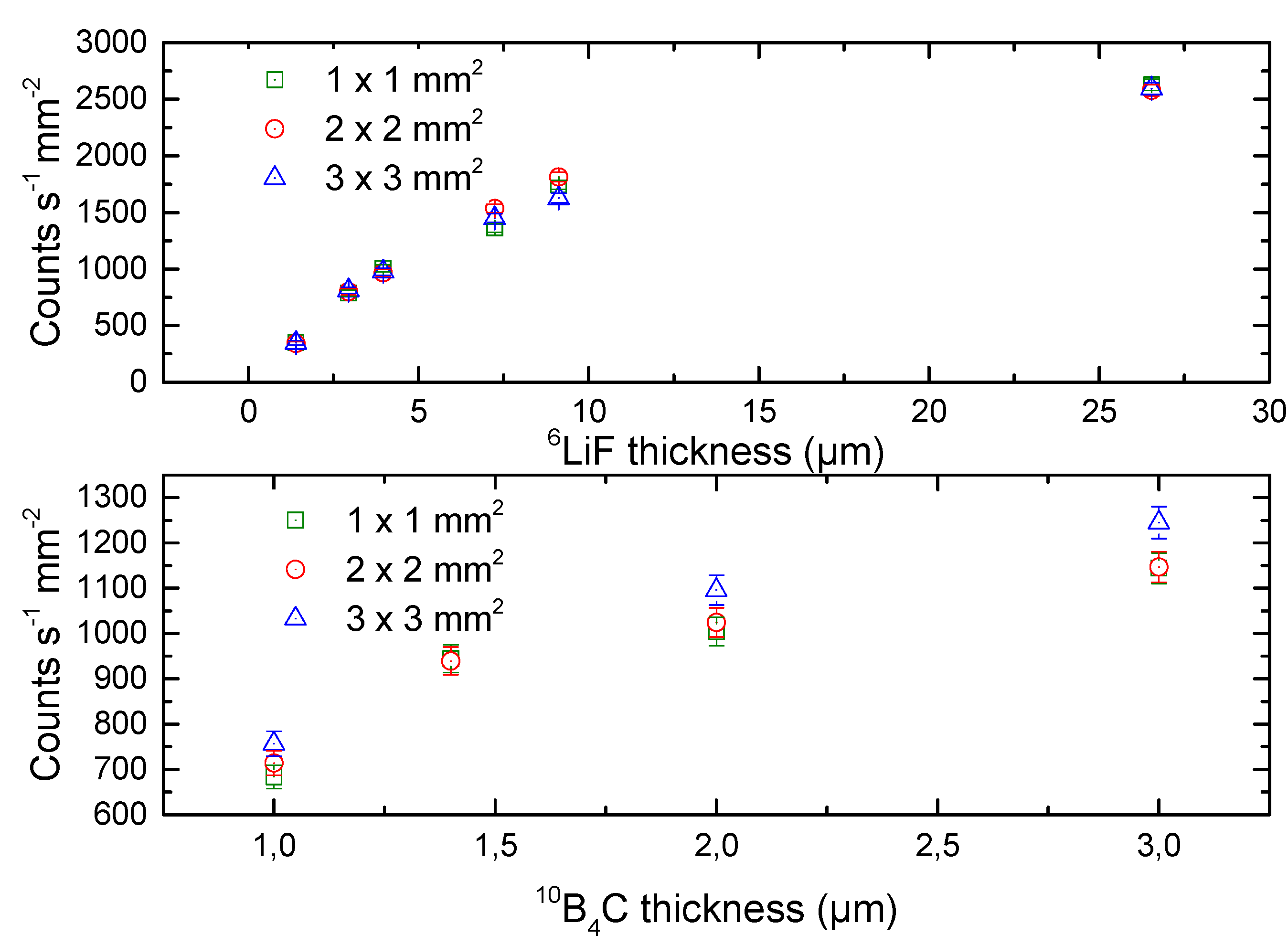4H-SiC Schottky Barrier Diodes for Efficient Thermal Neutron Detection
Abstract
:1. Introduction
2. Materials and Methods
2.1. H-SiC Schottky Barrier Diodes
2.2. Electrical Characterization of 4H-SiC SBD’s
2.3. Monte Carlo Simulations
2.4. Thermal Neutron Converters
2.5. Detector Read-Out System
3. Results
Neutron Response of the Detectors
4. Conclusions
Author Contributions
Funding
Institutional Review Board Statement
Informed Consent Statement
Data Availability Statement
Acknowledgments
Conflicts of Interest
References
- Radulović, V.; Yamazaki, Y.; Pastuović, Ž.; Sarbutt, A.; Ambrožič, K.; Bernat, R.; Ereš, Z.; Coutinho, J.; Ohshima, T.; Capan, I.; et al. Silicon carbide neutron detector testing at the JSI TRIGA reactor for enhanced border and port security. Nucl. Instrum. Methods Phys. Res. Sect. A Accel. Spectrometers Detect. Assoc. Equip. 2020, 972, 164122. [Google Scholar] [CrossRef]
- Nava, F.; Vanni, P.; Bruzzi, M.; Lagomarsino, S.; Sciortino, S.; Wagner, G.; Lanzieri, C. Minimum ionizing and alpha particles detectors based on epitaxial semiconductor silicon carbide. IEEE Trans. Nucl. Sci. 2004, 51, 238–244. [Google Scholar] [CrossRef]
- Ruddy, F.H.; Seidel, J.G.; Chen, H.; Dulloo, A.R.; Ryu, S.H. High-resolution alpha-particle spectrometry using silicon carbide semiconductor detectors. IEEE Nucl. Sci. Symp. Conf. Rec. 2005, 3, 1231–1235. [Google Scholar] [CrossRef]
- Sedlačková, K.; Zaťko, B.; Šagátová, A.; Necas, V. The effect of the LiF film topology on detection properties of thermal neutron semiconductor detectors. In Proceedings of the APCOM 2017: 23rd International Conference on Applied Physics of Condensed Matter, Štrbské Pleso, Slovak, 12–14 June 2017; pp. 125–129. [Google Scholar]
- Coutinho, J.; Torres, V.J.B.; Capan, I.; Brodar, T.; Ereš, Z.; Bernat, R.; Radulović, V. Silicon carbide diodes for neutron detection. Nucl. Inst. Methods Phys. Res. A 2020, 986, 164793. [Google Scholar] [CrossRef]
- Bernat, R.; Capan, I.; Bakrač, L.; Brodar, T.; Makino, T.; Ohshima, T.; Pastuović, Ž.; Sarbutt, A. Response of 4h-sic detectors to ionizing particles. Crystals 2021, 11, 10. [Google Scholar] [CrossRef]
- Ruddy, F.H.; Dulloo, A.R.; Seidel, J.G.; Palmour, J.W.; Singh, R. The charged particle response of silicon carbide semiconductor radiation detectors. Nucl. Instrum. Methods Phys. Res. Sect. A Accel. Spectrometers Detect. Assoc. Equip. 2003, 505, 159–162. [Google Scholar] [CrossRef]
- Flammang, R.W.; Seidel, J.G.; Ruddy, F.H. Fast neutron detection with silicon carbide semiconductor radiation detectors. Nucl. Instrum. Methods Phys. Res. Sect. A Accel. Spectrometers Detect. Assoc. Equip. 2007, 579, 177–179. [Google Scholar] [CrossRef]
- Lioliou, G.; Chan, H.K.; Gohil, T.; Vassilevski, K.V.; Wright, N.G.; Horsfall, A.B.; Barnett, A.M. 4H-SiC Schottky diode arrays for X-ray detection. Nucl. Instrum. Methods Phys. Res. Sect. A Accel. Spectrometers Detect. Assoc. Equip. 2016, 840, 145–152. [Google Scholar] [CrossRef] [Green Version]
- Hagiwara, K.; Yano, T.; Tanaka, T.; Reen, M.S.; Das, P.K.; Lorenz, S.; Ou, I.; Sudo, T.; Yamada, Y.; Mori, T.; et al. Gamma-ray spectrum from thermal neutron capture on gadolinium-157. Prog. Theor. Exp. Phys. 2019, 2019, 23D01. [Google Scholar] [CrossRef]
- Knoll, G.F. Radiation Detection and Measurement, 4th ed.; Wiley: Hoboken, NJ, USA, 2010. [Google Scholar]
- Landsberger, S.; Tsoulfanidis, N. Measurement & Detection of Radiation, 4th ed.; CRC Press: Boca Raton, FL, USA, 2015; ISBN 9781482215489. [Google Scholar]
- McGregor, D.S.; Hammig, M.D.; Yang, Y.H.; Gersch, H.K.; Klann, R.T. Design considerations for thin film coated semiconductor thermal neutron detectors—I: Basics regarding alpha particle emitting neutron reactive films. Nucl. Instrum. Methods Phys. Res. Sect. A Accel. Spectrometers Detect. Assoc. Equip. 2003, 500, 272–308. [Google Scholar] [CrossRef]
- Kim, H.S.; Ho Ha, J.; Park, S.H.; Lee, S.W.; Moon, M.K.; Sun, G.M.; Lee, C.H. Characteristics of fabricated neutron detectors based on a sic semiconductor. J. Nucl. Sci. Technol. 2011, 48, 1343–1347. [Google Scholar] [CrossRef]
- Manfredotti, C.; Lo Giudice, A.; Fasolo, F.; Vittone, E.; Paolini, C.; Fizzotti, F.; Zanini, A.; Wagner, G.; Lanzieri, C. SiC detectors for neutron monitoring. Nucl. Instrum. Methods Phys. Res. Sect. A Accel. Spectrometers Detect. Assoc. Equip. 2005, 552, 131–137. [Google Scholar] [CrossRef]
- Ziegler, J.F.; Biersack, J.P. The Stopping and Range of Ions in Matter. In Treatise on Heavy-Ion Science; Springer: Boston, MA, USA, 1985; pp. 93–129. [Google Scholar]
- Ziegler, J.F.; Ziegler, M.D.; Biersack, J.P. SRIM—The stopping and range of ions in matter (2010). Nucl. Instrum. Methods Phys. Res. Sect. B Beam Interact. Mater. Atoms 2010, 268, 1818–1823. [Google Scholar] [CrossRef] [Green Version]
- Mandić, I.; Cindro, V.; Kramberger, G.; Krištof, E.S.; Mikuž, M.; Vrtačnik, D.; Ullan, M.; Anghinolfi, F. Bulk damage in DMILL npn bipolar transistors caused by thermal neutrons versus protons and fast neutrons. IEEE Trans. Nucl. Sci. 2004, 51, 1752–1758. [Google Scholar] [CrossRef]
- Mandié, I.; Cindro, V.; Gorišek, A.; Kramberger, G.; Mikuž, M. Online integrating radiation monitoring system for the ATLAS detector at the large hadron collider. IEEE Trans. Nucl. Sci. 2007, 54, 1143–1150. [Google Scholar] [CrossRef]
- Gerhardt, R. Properties and Applications of Silicon Carbide; InTech: Rijeka, Croatia, 2011; ISBN 0886-4470. [Google Scholar]
- Lo Giudice, A.; Fasolo, F.; Durisi, E.; Manfredotti, C.; Vittone, E.; Fizzotti, F.; Zanini, A.; Rosi, G. Performances of 4H-SiC Schottky diodes as neutron detectors. Nucl. Instrum. Methods Phys. Res. Sect. A Accel. Spectrometers Detect. Assoc. Equip. 2007, 583, 177–180. [Google Scholar] [CrossRef]
- Sedlačková, K.; Zat’ko, B.; Šagátová, A.; Nečas, V.; Boháček, P.; Sekáčová, M. Comparison of semi-insulating GaAs and 4H-SiC-based semiconductor detectors covered by LiF film for thermal neutron detection. Appl. Surf. Sci. 2018, 461, 242–248. [Google Scholar] [CrossRef]
- Uher, J.; Holý, T.; Jakůbek, J.; Lehmann, E.; Pospíšil, S.; Vacík, J. Performance of a pixel detector suited for slow neutrons. Nucl. Instrum. Methods Phys. Res. Sect. A Accel. Spectrometers Detect. Assoc. Equip. 2005, 542, 283–287. [Google Scholar] [CrossRef]
- Brodar, T.; Capan, I.; Radulović, V.; Snoj, L.; Pastuović, Ž.; Coutinho, J.; Ohshima, T. Laplace DLTS study of deep defects created in neutron-irradiated n-type 4H-SiC. Nucl. Instrum. Methods Phys. Res. Sect. B Beam Interact. Mater. Atoms 2018, 437, 27–31. [Google Scholar] [CrossRef] [Green Version]
- Capan, I.; Brodar, T.; Coutinho, J.; Ohshima, T.; Markevich, V.P.; Peaker, A.R. Acceptor levels of the carbon vacancy in $4H$-SiC: Combining Laplace deep level transient spectroscopy with density functional modeling. J. Appl. Phys. 2018, 124, 245701. [Google Scholar] [CrossRef] [Green Version]
- Capan, I.; Brodar, T.; Pastuović, Z.; Siegele, R.; Ohshima, T.; Sato, S.I.; Makino, T.; Snoj, L.; Radulović, V.; Coutinho, J.; et al. Double negatively charged carbon vacancy at the h- and k-sites in 4H-SiC: Combined Laplace-DLTS and DFT study. J. Appl. Phys. 2018, 123, 161597. [Google Scholar] [CrossRef] [Green Version]




| Monte Carlo Code | Simulated Thermal Neutron Converter Thickness for the Highest Range of Selected Particles | |||
|---|---|---|---|---|
| α in 6Li(n, α)3H | 3H in 6Li(n, α)3H | α in 10B(n, α)7Li | 7Li in 10B(n, α)7Li | |
| MCNP6.2 | 5.8 µm | 33 µm | 2.6 µm | * |
| SRIM | 5.82 µm | 32.5 µm | 3.14 µm | 1.58 µm |
| Converter | Thickness (μm) | Sensitivity (Counts s−1 per n cm−2s−1) | Efficiency (%) |
|---|---|---|---|
| 10B4C | 1.0 | 1.23 × 10−3 | 1.36 |
| 10B4C | 1.4 | 1.66 × 10−3 | 1.84 |
| 10B4C | 2.0 | 1.78 × 10−3 | 1.97 |
| 10B4C | 3.0 | 2.02 × 10−3 | 2.24 |
| 6LiF | 1.4 | 5.64 × 10−4 | 0.63 |
| 6LiF | 2.94 | 1.31 × 10−3 | 1.46 |
| 6LiF | 3.96 | 1.59 × 10−3 | 1.76 |
| 6LiF | 7.24 | 2.35 × 10−3 | 2.61 |
| 6LiF | 9.12 | 2.64 × 10−3 | 2.93 |
| 6LiF | 26.54 | 4.20 × 10−3 | 4.67 |
Publisher’s Note: MDPI stays neutral with regard to jurisdictional claims in published maps and institutional affiliations. |
© 2021 by the authors. Licensee MDPI, Basel, Switzerland. This article is an open access article distributed under the terms and conditions of the Creative Commons Attribution (CC BY) license (https://creativecommons.org/licenses/by/4.0/).
Share and Cite
Bernat, R.; Bakrač, L.; Radulović, V.; Snoj, L.; Makino, T.; Ohshima, T.; Pastuović, Ž.; Capan, I. 4H-SiC Schottky Barrier Diodes for Efficient Thermal Neutron Detection. Materials 2021, 14, 5105. https://doi.org/10.3390/ma14175105
Bernat R, Bakrač L, Radulović V, Snoj L, Makino T, Ohshima T, Pastuović Ž, Capan I. 4H-SiC Schottky Barrier Diodes for Efficient Thermal Neutron Detection. Materials. 2021; 14(17):5105. https://doi.org/10.3390/ma14175105
Chicago/Turabian StyleBernat, Robert, Luka Bakrač, Vladimir Radulović, Luka Snoj, Takahiro Makino, Takeshi Ohshima, Željko Pastuović, and Ivana Capan. 2021. "4H-SiC Schottky Barrier Diodes for Efficient Thermal Neutron Detection" Materials 14, no. 17: 5105. https://doi.org/10.3390/ma14175105









